What follows is our official exit interview with Amanda Sari Perez, who just recently left Ann Arbor for Pittsburgh.
MARK: OK, let’s start at the beginning. What’s your name, where were you born, and what kind of kid were you?
AMANDA: All right then. My name is Amanda. Or Salamanda. Or YakYak. Or AmandaPanda. I was born in Hong Kong, but I was only there for two weeks. And I was the kind of kid who could play with insects for hours. Actually that’s the kind of adult I am now, too.
MARK: Why so many aliases?
AMANDA: I have friends who like to give me weird names. In the case of YakYak, a friend sent out a message inviting a group of us to ride their yaks. I was so excited by the idea of riding live yaks that I started looking up images on Google and sending photos of the animal to our message thread, exclaiming, “Oh my god, guys, we get to ride yaks!” I remember the owner responded, “Just watch out for the fleas!” Well, a few days later, I showed up in the countryside to ride these yaks, only to find out that they’d been referring to kayaks. Apparently they’d started f*ing with me once they realized I’d completely misunderstood. In my defense, the friend with the kayaks is totally the kind of person who would own live yaks. (I’m looking at you, Trudi Cooper.)
[above: A photo taken just seconds after Amanda was christened “YakYak”.]
MARK: You mentioned having a love of insects as a kid. What is it about them that interested you?
AMANDA: When I was young, I just found them inherently fascinating to watch. I think there’s something sort of machine-like about them, and yet they’re living. They seem like simple organisms because they’re so small and appear emotionless. But biologically, they’re just as complex as we are. Their small size makes them seem more approachable to me. They’re also just a visually beautiful part of nature.
MARK: Why is it that you left Hong Kong after just two weeks?
AMANDA: Well, the backstory is that my parents moved around a lot for my dad’s job (he worked as a petroleum engineer), and when my mom was pregnant with me, they were living in Beijing, China. At that time, Hong Kong belonged to the British. My mom flew to Hong Kong a few days before I was born just to pop out her kid in British territory, and then we all went back to China.
[above: Amanda, seen second from right, celebrating “Sports Day” at her international school in Libya.]
MARK: How did your parents meet?
AMANDA: My dad, who’s from Bolivia, took a job in Indonesia, where my mom is from, and they met while working at the same company. They started dating, and eventually my mom moved with him when he had to leave the country for his next job. I once asked her what she had wanted out of life when she was younger. Her response was, “I wanted to see the world… and I got more than I could have hoped for.”
MARK: What’s your first memory?
AMANDA: Good question! I have a very fuzzy snapshot of my first day of preschool. I think I remember my mom dropping me off. And a Care Bear thermos, there was a Care Bear thermos… Do you remember your first memory?
MARK: Yeah, that’s the reason I ask people that question. For as long as I can remember, I’ve had this one very distinct memory of being a really young kid. We were living in Monticello, Kentucky at the time, so I was probably about two years old. It was daylight outside, and my mom must have just put me down for a nap. The window was open, and I remember looking up at this yellow curtain, just watching in blow in the breeze. It was just this perfect moment on a warm day, laying there in the sunlight, listening to the sounds outside my bedroom window… So, back to you… What brought you to Ann Arbor?
AMANDA: College, about twelve years ago. Admittedly, I went to college because it was the “next thing” to do, and I never considered not going. When I was choosing schools to apply to, I liked Michigan because it was far away from Texas.
MARK: What was it about Texas that you were hoping to escape?
AMANDA: I think I just didn’t really fit in Houston. That’s the more diplomatic answer. The way I experienced it at the time was: I felt like an outsider, especially since I was foreign. When I was 10 years old, I encountered some bigotry there. We left, and then returned when I was 14. I found the culture of my high school to be insular and very image obsessed, which made me feel isolated and depressed. Especially in those inexperienced teenage years.
MARK: And did you find what you were looking for in Ann Arbor? Was it the proper antidote for Texas?
AMANDA: Over time, absolutely. I found people who were open minded and down-to-earth. I found people who were actively creative. Perhaps most importantly, I found a sense of community and some purpose in that. I hadn’t understood, prior to that, how helpful it feels to belong to something.
[above: Night out at Burning Man.]
MARK: So, do I understand correctly that you just recently left Ann Arbor?
AMANDA: Yep, I left at the end of August.
MARK: When did you decide that it was time for you to leave? Was there a specific moment?
AMANDA: Not exactly. I’d been feeling stuck for years, working as a research associate in academia — basically a lab technician — and it really wasn’t for me. The decision to move was about finding something I loved doing that was also a stable career. I figured my best bet was to get trained in grad school, and even though I didn’t have a specific place in mind, I knew it would be better to start in a fresh environment without all the history of my undergrad years. (Long story short: I was not a model student back then. In many ways, I was still dealing with issues from my years in Texas.)
So I was afraid to apply to grad schools because my undergrad GPA wasn’t stellar, and in general, I was hard on myself for being irresponsible. It’s why I put off applying for so many years. The positive side is that I gained a lot of work experience, and I kept working on creative projects on the side. It gave me time to piece together all of my interests and develop some direction.
In that time I also met two amazing souls, Tamara and Eagleheart, and through them, I joined a community that created space to ask deeply personal questions. I confronted questions like: what was I so afraid, or ashamed of, and why didn’t I trust myself? My time with them transformed me, and prepared me to face the world again… So I applied to grad schools one year, didn’t get in anywhere, applied the next year, and, by some grace, I got into the school I wanted most.
MARK: How did Ann Arbor change over the time that you were here?
AMANDA: Well, there are definitely a lot more condos now. When I first arrived here, State Street still felt quaint. I remember all the students went to Shaman Drum Bookshop to get their textbooks, and I wouldn’t have ever imagined a Walgreens or CVS. Not that I’m really complaining about CVS — I liked the convenience of being able to buy toiletries within walking distance. But Ann Arbor has definitely been losing its unique townie vibe and local shops to national chains.
There have been some great additions to Ann Arbor that service the community, like Maker Works! And I think Fool Moon started after I arrived too.
MARK: So where will you be going to grad school, and what are you hoping to study?
AMANDA: I’m at Carnegie Mellon in Pittsburgh now. I’m in the Biomedical Engineering program. There’s a second component, which I’ll start next year, and that’s a technology and innovation management program.
MARK: I really like Pittsburgh. Be sure to check out the Warhol Museum.
AMANDA: Oh yeah? Okay, I hadn’t even heard of it yet. I’ll be sure to check it out. Let me know if there’s anything else you recommend around here.
MARK: My kids like to ride the Duquesne Incline. And the Carnegie Museum of Natural History is worth some time. Oh, and be sure to eat sandwiches with french fries on them. And I know there was a bar that I liked. I can’t remember the name, though. All I can remember is that it was a little place, and King Kong was playing on a television. And I think it may be within walking distance of a brewery inside of a church, where we had dinner just beforehand.
AMANDA: Yeah, I really want to go up the Incline. I’ve heard that the view is gorgeous. I went on a little boat tour along the rivers, and the landscape of this city is really stunning. Sandwich with french fries — noted. And I’ll be on the lookout for bars that are likely to play King Kong.
MARK: And what would the ideal career be after graduating?
AMANDA: Part of the next two years in this program is figuring out exactly that. I came here because I wanted to work on motor rehabilitation (i.e. devising solutions for people who have lost some motion, like from limb loss or paralysis). For now, I just want to get a better understanding of the physiological problem, how it’s being addressed by the biomedical community, and what is its place in the biotech industry. So it’s a little difficult to say while I’m still naive about it, and I would like to work at a biotech company, probably as a product manager. However, I’ve thought several times about opening up a rehabilitation center that combines helpful technological intervention with more holistic approaches to help people reintegrate into their bodies after trauma. I just imagine if I ever lost the ability to move around freely, what would be necessary for me to feel like I’ve regained my sense of agency. I’d like to ask that of patients.
All that said, I’ve heard some good advice recently (from several people who didn’t know they were offering good advice) to focus more on finding the skills that I love rather than the goal career.
MARK: If I remember correctly, our paths first crossed about three or four years ago, when the other members of the Ann Arbor Awesome Foundation and I voted to give you a $1,000 grant to build a dome. Is that right?
AMANDA: Yeah! That’s right. Thanks for that. Constructing that dome was a really fun group experience, and it’s been used many times by different people since. The Awesome Foundation is really, well, awesome. It’s really awesome for the board of trustees to volunteer their time and money to fund cool ideas like that.
[above: The first time assembling the dome.]
MARK: What, if anything, will you miss about Ann Arbor?
AMANDA: Oh god, what won’t I miss… I’ll probably miss the people the most. I miss them already. I met lots of down-to-earth, creative people over the years that became close friends. I could go on for a long time about how inspired I am by these people. The whole town is really friendly, too. It feels like most people are approachable. I’ll miss the easy access to the river and the wooded areas around it. And I’ll miss the opportunities that Ann Arbor offers — for instance the Awesome Foundation you mentioned. I felt like if I wanted to do something on a community scale in Ann Arbor, it was a small enough town that I could find space to do it, but large enough to find good people to join. And until I find an adequate replacement, I miss freshly squeezed OJ from Sparrow Market.
MARK: What are you most proud of having accomplished while you were here?
AMANDA: Probably the projects I did with Syncytium. That’s the group of people who builds projects for Burning Man and Lakes of Fire, but over time, some of us focused on displaying them at home in Ann Arbor. I’m really proud of an immersive, interactive game project that was the brainchild of me, Theresa Carranza, and Suby Raman. We really put forth the ideas we wanted to see most, and we made it happen. I’d say I’m most proud of the community, friendships, and sense of creative exploration that Syncytium fostered. It has a lot of heart, and some wickedly skilled people… On a personal note, I’m proud that I faced some past baggage over the last two years to finally move forward with my life, and I’m so grateful to the people who helped me with that.
[above: Cutting metal struts for the Breaking Protocol game.]
MARK: How did you first get involved in the Ann Arbor maker scene?
AMANDA: After college, I realized I’d spent a lot of time taking in ideas, but not a lot of time producing the ideas that I had. I got tired of just talking about what I wanted to do, and I got tired of hearing other people just talk about what they wanted to do. So in 2009, I started a small “Do It Club” with some friends, where we made a few of our ideas into reality (fondest memory: creating Pacman out of two shopping carts for the shopping cart race). It was small, but it felt really good to create something with my hands. About a month into that, I got an email from Josh Williams introducing me to Bilal Ghalib, who was returning to town and wanted to start a makerspace. That’s how I was introduced to the concept of makerspaces and DIY fabrication, and so a handful of us started All Hands Active, the makerspace downtown.
MARK: And your interest has just grown since then?
AMANDA: Yeah, it started with Bilal. He inspired me. He made me believe that I had the power to create things, and make change. And then the maker scene and Burning Man culture instilled the notion that, if I want to create something that doesn’t exist, I could pull the resources together to make it happen. It’s been an amazing ride of physically building large installations (like the dome, and the immersive interactive game), going through the creative process with a group, and being open to learning new skills that were initially intimidating.
[above: Sunrise at Burning Man in found Tyvek suits.]
MARK: As you brought up Burning Man, I’m curious to know what you think of its evolution. It seems, over the last few years, I’ve just been reading more and more about how it’s becoming a playground for the super rich.
AMANDA: You know, that’s true, there are pockets where very rich people pay to have their whole experience catered to them, but I’ve personally never run into them. It’s a newer part of Burning Man, and it makes sense for some media outlets to want to expose that, but its actual presence at the burn is not proportional to the amount of media attention it gets. It also doesn’t have a big effect on the other attendees (as far as I know). At the end of the day, you go, you give what you want to give, you let yourself be as vulnerable as you want to be, and that is what determines the sort of experience you’ll have. In my opinion, if people pay a lot of money to avoid work, or facing the harsh elements of the desert, they’re missing out on a lot of what Burning Man has to offer.
I’d say the more troubling thing I saw the last couple of times I went was a lot of newcomers who weren’t familiar with the culture, and maybe just thought it was a scene to party. It takes a critical mass of veterans, even people who were just there for one year, to set an example and keep passing on the culture that this is a community effort, and it’s really about giving and being engaged. I didn’t go last year or this year, though, so I can’t say if that’s still true. I heard this year was amazing though, especially with the incredible art!
MARK: So, you didn’t go?
AMANDA: Nope, I took a break from the burn because I was investing a fair amount of time and money into it. And I’m glad I invested that effort; I received a lot in return. However, I also started seeing it as a practice zone, a safer place to take risks, and I wasn’t taking that practice out into the real world.
At the burn, you can embark on an ambitious project, or you can step out of your social comfort zone, and if you fail, nobody loses a job; you’re met with a receptive audience instead of a resistant one; and the slate is practically wiped clean at the end when everything is burned. You also have this communal spirit where everyone is pushing their boundaries and letting their guard down. After a while, it started to become an easy escape from what I was really afraid of: facing the “real” world and my fear that it still wasn’t so receptive of me. My avoidance was making me feel more alienated from it, and I had to reconnect. I decided to jump back in, and practice the important lessons: having the guts to try, and trusting in myself and my environment. So for the last two years, instead of going to the burn, I spent the time and money preparing for grad school and taking courses related to the field I want to work in.
MARK: If the people of Ann Arbor were to build a statue of you, commemorating the time that you spent here, where would it be, and what would the statue of you be doing?
AMANDA: I think I would feel really awkward having a statue. Unless it was like me with a chipmunk on my shoulder or something. Or riding a yak. One thing that came to mind was a little monument of stones on a little raft that could be floated down the river, like the way they sent off old eskimos on ice floats. The other thing that came to mind was a statue made of bacon, probably because it’s one of the foods associated (somewhat jokingly, somewhat seriously) with Burning Man. At the very least, I’d like it to be made of something edible that people could eat and enjoy, and it would be at my friend Matt K’s backyard, where we built most of our recent projects while people shot BB guns at paint cans in front of a bonfire.
[above: On the raft build for Float Fest.]
MARK: Any parting words for the people of Ann Arbor?
AMANDA: To the city and to people I know: thanks, and I love you. To the general population: float down the cascades with a group of people on an air mattress, you won’t regret it.
[Curious as to why people are leaving this place we call home? Check out the Ypsi/Arbor Exit Interview archive.]

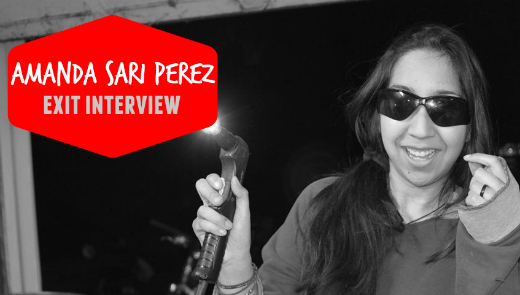
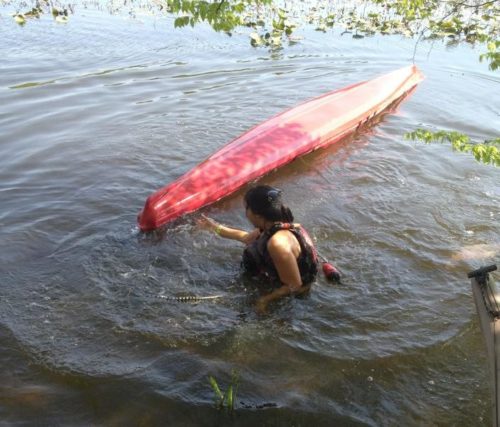


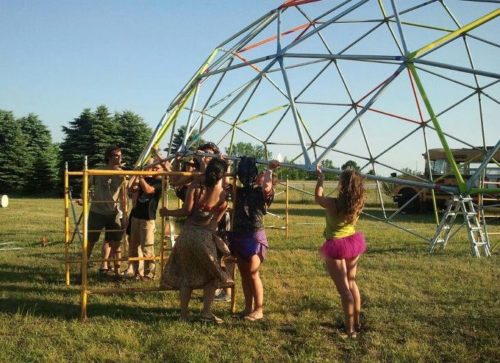
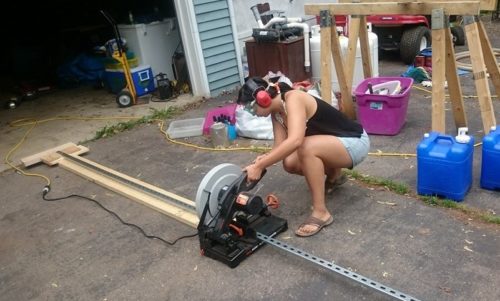
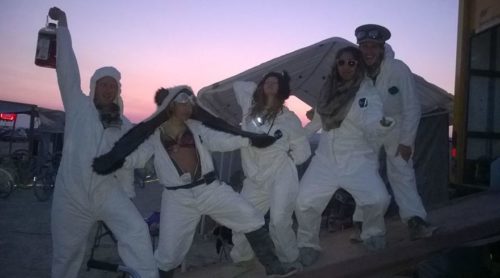
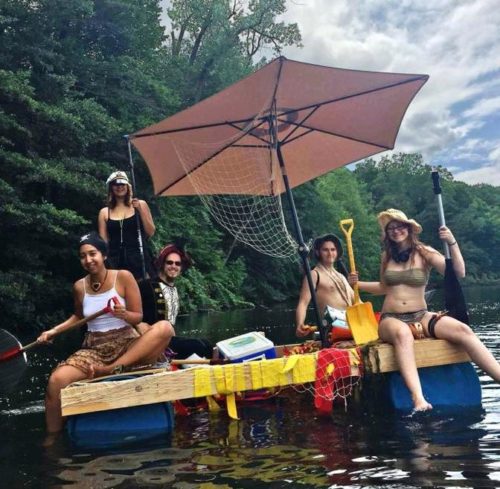











5 Comments
Women making things for themselves. When will this madness end? Please, Donald Trump, save us!
There’s nothing sexier or cooler than woman using power tools.
What a lovely story, YakYak! Miss you so, come visit often.
She may be good at building things, but that sail isn’t going to catch any wind.
(Good luck at Carnegie Mellon.)
Shout out to one of the most positive, creative, beautiful and considerate people I’ve ever met. Bar none. Enjoy the journey Amanda Sari Perez.